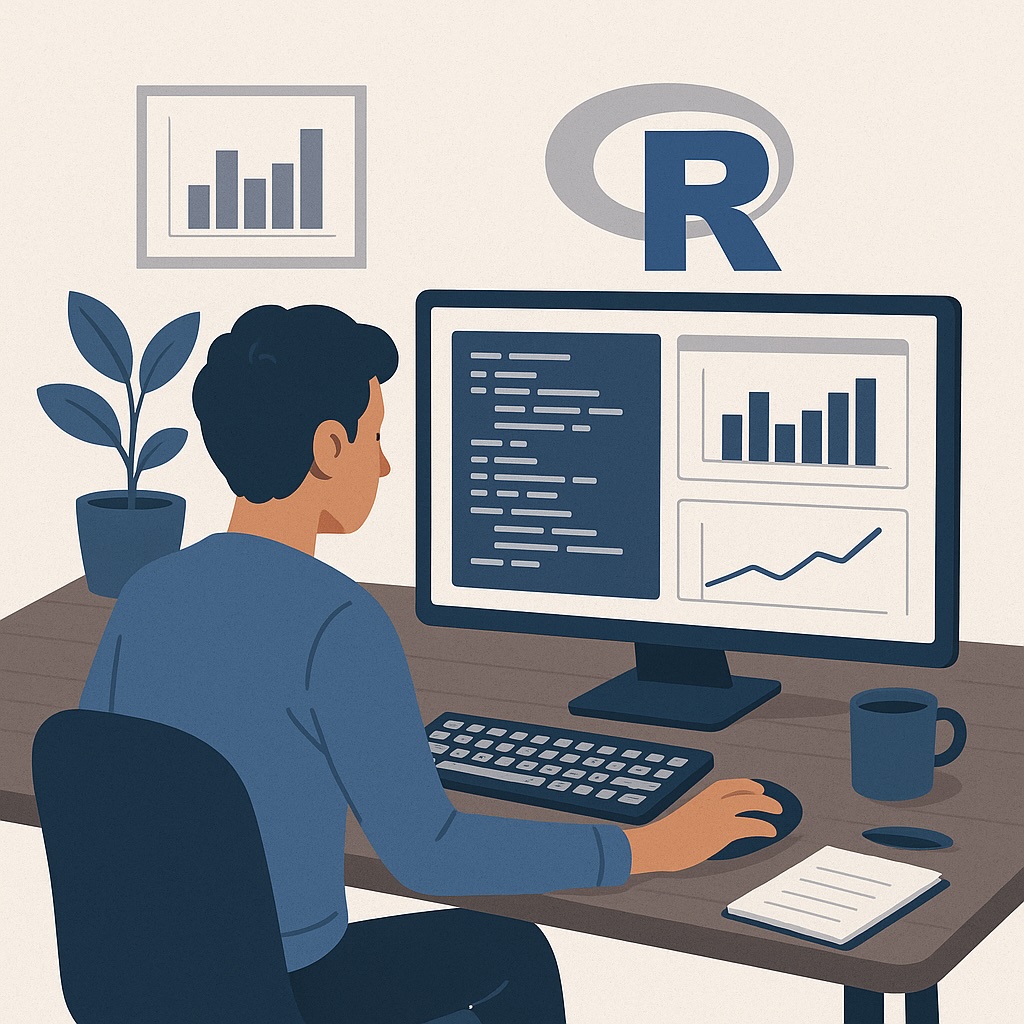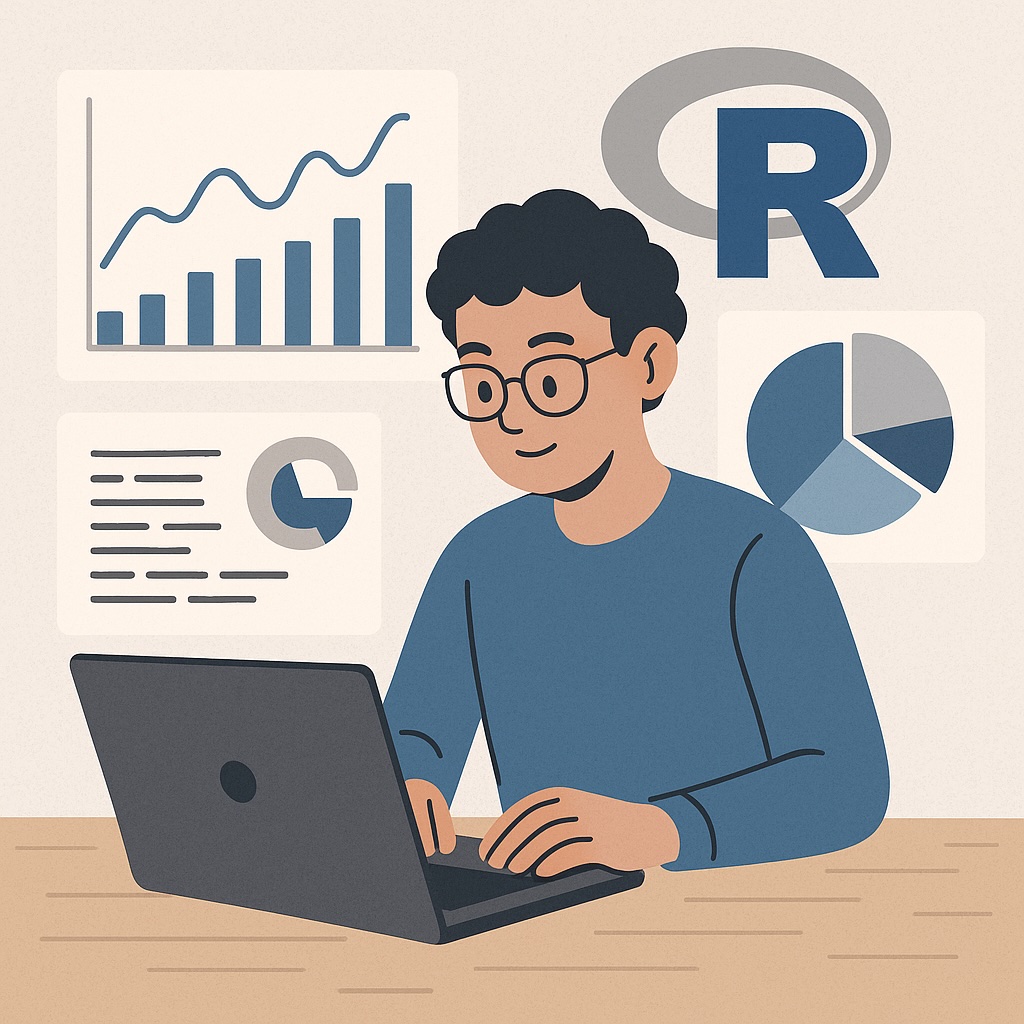R: a brief exploration
Introduction
R is a powerful open-source programming language and software environment used worldwide for statistical analysis, data manipulation, and data visualization. Developed by Ross Ihaka and Robert Gentleman at the University of Auckland, New Zealand, and now maintained by the R Core Team, R has its roots in the S language from Bell Laboratories, influenced by languages such as Scheme and Lisp. Thanks to its flexibility, extensive package library, and strong analytical capabilities, R has become an essential tool for data scientists, statisticians, and researchers across various sectors.
Features of R
R is an object-oriented programming language that excels in statistical computations, machine learning, and advanced data visualizations. The language offers extensive support for regression analysis, time series analysis, clustering, and data mining. With the vast number of available packages, R can be easily extended and customized to meet specific project needs. Additionally, R is highly capable of processing large datasets (big data) and offers powerful tools for data cleaning, aggregation, and analysis. The active and innovative R community ensures that users always have access to the latest techniques and applications.
Graphical Capabilities
A distinctive feature of R is its ability to create high-quality, professional data visualizations. With packages like ggplot2, plotly, and Shiny, users can develop fully customizable interactive charts and dashboards. R supports the inclusion of complex mathematical notations and offers export options to formats such as PNG, PDF, and SVG. Thanks to the flexibility and power of R visualizations, data analyses can be presented not only insightfully but also visually attractively, which is essential for reporting and decision-making.
Data Manipulation
R excels in data manipulation and offers powerful tools like dplyr, tidyr, and data.table to efficiently edit datasets. Users can easily clean, transform, summarize, and combine data, regardless of the size or complexity of the datasets. R supports a wide range of data sources, including CSV files, Excel documents, SQL databases, and web APIs. Moreover, R enables the integration of workflows with other programming languages such as Python and SQL, significantly enhancing R’s flexibility and applicability within complex data pipelines.
Machine Learning and Data Science
R offers extensive support for machine learning and data science. With leading packages like caret, randomForest, xgboost, and tidymodels, users can easily build, validate, and optimize predictive models. R supports both supervised and unsupervised learning techniques and makes it simple to evaluate model performance through methods like cross-validation and ROC analysis. Thanks to the continuous development within the R community, there are growing opportunities for deep learning, natural language processing (NLP), and image recognition within the R ecosystem.
Applications and Usage
R is widely used across sectors such as healthcare, financial services, marketing, government, and academia. In the academic world, R remains a leading tool for statistical research and data analysis, while companies use R for customer segmentation, market analysis, risk analysis, and process optimization. Thanks to R’s scalability and flexibility, both startups and multinational corporations can benefit from the powerful analytical capabilities the language offers. R also plays an important role in the rapidly growing field of business intelligence and data-driven decision-making.
Community and Support
The global R community is one of the language’s greatest strengths. With a wealth of forums, open-source contributions, blogs, webinars, and conferences, support is always within reach. The R Foundation and many independent developers continuously work on improving and innovating the language. For beginners and advanced users, countless online courses, manuals, and tutorials are available, making R accessible to anyone looking to develop or deepen their skills in data analysis and data science.

R and Statistics
Introduction to Statistics in R
Statistics form the backbone of data analysis, and R was specifically developed to enable powerful statistical computations. The platform offers an impressive range of techniques, such as linear regression, ANOVA, t-tests, chi-square tests, and correlation analysis. These fundamental methods are essential for analyzing datasets and drawing reliable conclusions. Thanks to its extensive capabilities, R remains a favorite among data analysts, researchers, and statisticians worldwide.
Advanced Statistical Techniques in R
For users who want to go beyond basic statistics, R offers a wide range of advanced techniques. Think of machine learning, cluster analysis, time series analysis, and survival analysis. With powerful packages like caret, tidymodels, and new frameworks like mlr3, data scientists can easily build and evaluate complex models. This makes R ideal for discovering deeper patterns, making predictions, and optimizing decision-making processes.
Bayesian Statistics in R
R offers excellent support for Bayesian statistics, an approach increasingly favored in biostatistics, econometrics, psychology, and data science. Bayesian methods, through packages like rstan and brms, make it possible to model uncertainties in a flexible and intuitive way. This opens new possibilities for analysis, especially when classical frequentist methods fall short.
Data Visualization in R
R excels in data visualization. With popular packages such as ggplot2, plotly, and lattice, users can present complex datasets in a visually appealing and insightful way. Good visualizations are essential to quickly recognize trends, patterns, and anomalies and to communicate effectively. R offers the flexibility to create both static and interactive graphs that enhance analyses and bring stories to life.
Standardized Work with Statistical Models
R follows a standardized approach for building and interpreting statistical models. Once you are familiar with setting up, for example, a linear model, you can easily apply this knowledge to other techniques such as generalized linear models, mixed-effects models, or machine learning applications. Thanks to its consistent structure and excellent documentation, both beginner and experienced users can work efficiently and quickly grow their skills.
Conclusion
R is the complete environment for statistics and data analysis. From simple statistical tests to advanced techniques such as machine learning and Bayesian modeling: R combines power, flexibility, and user-friendliness. This makes it an indispensable tool for anyone seriously engaged in data analysis, research, and data-driven decision-making.

R and data visualization
R remains one of the most powerful tools for data visualization, an essential part of data management and data analysis. With R, you can effortlessly gain visual insights into datasets through a variety of charts and diagrams, such as scatterplots, bar charts, line graphs, boxplots, and heatmaps. In this article, you will discover the latest capabilities of R for data visualization, with special attention to the popular package ggplot2, known worldwide for its power, flexibility, and ease of use.
Why choose R for data visualization?
R has evolved into one of the most versatile and reliable platforms for data visualization. It offers extensive graphic capabilities and excels at processing, analyzing, and presenting large volumes of data. Thanks to R's flexibility, users can create visually appealing, clear, and impactful charts. This makes R the go-to choice for data scientists, analysts, and researchers who want to effectively convey their insights.
The power of ggplot2
Within the R ecosystem, ggplot2 stands out as a top choice. As part of the tidyverse, ggplot2 helps users efficiently create high-quality visualizations. The package is based on the "grammar of graphics," an innovative approach that ensures a structured, consistent, and modular method for designing charts. This allows users to build even the most complex visualizations in a clear and logical way.
What makes ggplot2 unique is its unparalleled flexibility. From colors, styles, and labels to combining multiple datasets in a single chart—everything is fully customizable. Thanks to these features, users can develop finely tuned, professional visualizations that precisely match the intended message or analysis.
Types of charts in R
R supports a wide range of chart types, suitable for different analytical applications and data forms. The most popular charts you can create with R and ggplot2 include:
- Scatterplots – Perfect for showing the relationship between two continuous variables.
- Bar charts – Ideal for comparing discrete data or categories.
- Line graphs – Great for visualizing trends and developments over time.
- Boxplots – Useful for displaying data spread and potential outliers.
- Heatmaps – Especially suited for visualizing intensity patterns, such as in correlation matrices.
Each chart type offers unique advantages and can be fully customized to powerfully communicate specific insights.
The advantages of the grammar-based approach
The "grammar of graphics" used by ggplot2 offers a clear and logical structure for building charts. By sequentially adding components such as data, geometries, axes, and aesthetics, a streamlined process is created that reduces errors and fosters creativity. This makes designing both simple and complex visualizations accessible to users of all levels.
Conclusion
R, combined with ggplot2, offers an unparalleled solution for data visualization. Whether you choose a simple bar chart or a complex, interactive graph, R enables you to present data in a visually compelling and structured way. Thanks to its powerful features, adaptability, and intuitive approach, R is an indispensable tool for anyone serious about data analysis and visual storytelling.

R and programming principles
The Basics of R: More Than Statistical Analysis
R was originally developed for statistical analysis and data visualization, but today the language offers much more. R features many characteristics familiar from traditional programming languages, such as variables, operators, different data types, control structures (like loops and conditional statements), and functions. This allows you not only to analyze and visualize data in R, but also to develop complex algorithms, predictive models, and even complete systems that are scalable and efficient.
Flexibility and Power: Programming Paradigms in R
R supports multiple programming paradigms, including procedural, object-oriented, and functional programming. This gives you the flexibility to choose the programming style that best fits your project or analysis. Thanks to its powerful support for vector and matrix operations, R is also highly suitable for computation-intensive tasks, such as machine learning, deep learning, big data analysis, and simulation models. Extensive libraries, such as dplyr, ggplot2, and caret, make it possible to perform data analyses more quickly and effectively.
R Keeps Evolving: Modern Capabilities
In the latest versions, R's programming capabilities have been further expanded with modern features, such as parallel processing, integration with other programming languages (including C++, Python, and Java), and support for cloud computing. As a result, R remains a leading choice for data scientists, statisticians, and analysts seeking a powerful, flexible, and open-source programming language for advanced data analysis and machine learning projects. Furthermore, the active R community continuously drives the development of new packages and innovations, ensuring that R’s capabilities keep growing.

R and data manipulation
Introduction
R is much more than a language for statistical analysis and visualization. With its extensive programming capabilities, R has evolved into a versatile tool for data manipulation, machine learning, and system development. In this article, we explore the key features of R and how they contribute to its power and popularity in the world of data analysis and data engineering.
Basic Features of R
R includes all the essential components of a modern programming language: variables, operators, data types, control structures like loops and conditions, functions, and object-oriented techniques. This foundation enables not only the analysis of datasets but also the development and automation of complex workflows and algorithms.
Statistical Analysis, Visualization, and Data Manipulation
R excels in statistical analysis, data visualization, and data manipulation. Popular packages such as dplyr, tidyr, and data.table make processing, transforming, and cleaning datasets simple and efficient. Combined with powerful graphical libraries like ggplot2, users can create rich visualizations to clearly present insights and convincingly communicate analyses.
Support for Machine Learning
R offers extensive support for machine learning applications. Packages like caret, randomForest, xgboost, and tidymodels make it possible to build, validate, and optimize predictive models. Both supervised and unsupervised learning are widely supported, making R a valuable choice for data scientists aiming to develop reliable machine learning solutions.
Flexibility in Programming Style
R supports multiple programming paradigms, including procedural, functional, and object-oriented programming. This flexibility allows developers to tailor their approach to the nature of their project. From simple scripts to scalable architectures, R provides the freedom to effectively apply any programming style.
Advanced Computational Capabilities
Thanks to native support for vector and matrix operations, R is highly suitable for computationally intensive tasks. With packages such as parallel and future, computational tasks can also be efficiently parallelized, which is essential when working with large datasets or complex simulations. This makes R ideal for applications in numerical optimization, data engineering, and scientific modeling.
Deep Learning and Natural Language Processing
R is also playing an increasingly important role in deep learning and natural language processing (NLP). Through packages like keras, tensorflow, and torch, users can build powerful neural networks within R. In the field of NLP, libraries such as text, quanteda, and tidytext are available, making text analysis, sentiment analysis, and topic modeling accessible to R users.
Conclusion
R has developed into a complete programming language for data science and beyond. With robust capabilities for statistical analysis, advanced data manipulation, machine learning, deep learning, and computational optimization, R remains a strategic choice for data scientists, researchers, and developers. Thanks to its flexibility and powerful ecosystem, R is indispensable for anyone looking to create data-driven insights and solutions.

R and Reproducibility
Reproducibility in Data Analysis
Reproducibility — the ability to consistently and reliably repeat results — is a cornerstone of both the scientific method and modern data analysis. In an era where data is increasingly crucial for decision-making, reproducibility is essential for making analyses transparent, verifiable, and reusable.
Why R Excels at Reproducibility
R excels at supporting reproducibility through the use of scripts in which every step of an analysis is carefully documented. Instead of manual operations or undocumented steps, R offers a structured way to build analyses that are fully transparent. These scripts are easy to share, allowing others to repeat, verify, and improve the entire analysis where necessary.
Moreover, R supports version control and integration with tools like Git, making changes in analyses transparent and trackable. This not only increases the reliability of your work but also makes collaboration within teams much more efficient.
The Power of R Markdown
In addition to regular scripts, R offers powerful capabilities for creating dynamic and reproducible reports with R Markdown. With R Markdown, you can combine text, R code, and the generated output (such as tables and charts) into one clear document. This captures the entire process — from data import and cleaning to analysis, visualization, and interpretation — in a single source file.
A major advantage of R Markdown is its flexibility in export options: you can easily convert your document into HTML, PDF, or Word, depending on your audience’s needs. This not only makes documenting, sharing, and presenting analyses simpler and more efficient but also significantly enhances the transparency and reliability of your work.
Conclusion: An Indispensable Combination
R and R Markdown together form an indispensable combination for anyone striving for professional, reproducible data analysis. By documenting and making every step of your work accessible, you lay a strong foundation for collaboration, quality control, and continuous improvement of analyses.

The community
The Power of R and the Community
In addition to its powerful analytical capabilities, R offers a vibrant and rapidly growing global community of users and developers. Thanks to this active community, countless online resources are available, such as interactive tutorials, extensive blog posts, forums, and free courses, supporting both beginners and advanced users in improving their R skills.
Active Collaboration and Innovation
The R project continues to actively focus on collaboration, innovation, and knowledge sharing. Thanks to its open-source license, R is completely free to use, modify, and distribute. Thousands of developers worldwide contribute by creating new packages, optimizing existing packages, and adding new functionalities. As a result, R continues to develop dynamically and better meet the changing needs of data analysts, data scientists, and researchers.
Moreover, the open structure of R not only encourages the development of new applications but also the sharing of knowledge and best practices within the community. This allows users to benefit from the latest insights and methods in data analysis and visualization.
Local Groups and International Events
In addition to the online community, there are many local R user groups and conferences worldwide, such as the annual useR! conference. During these events, R users, developers, and thought leaders come together to share knowledge, present innovative solutions, and explore new trends.
These gatherings offer excellent opportunities for networking, professional growth, and deepening knowledge of the latest developments within the R community. Whether you are a beginner or an experienced professional, attending such events can significantly enhance your skills and insights.

Variants of R
R is a versatile programming language that is globally renowned for its strength in statistical analysis, data analysis, and data visualization. In addition to its extensive core functionalities, countless variants and extensions have been developed to optimize the user experience and further expand R’s application possibilities. Below, we discuss the most important variants of R, such as Shiny, each with their unique applications and advantages.
1. Base R
The standard version of R offers a robust collection of statistical functions, advanced graphical capabilities, and tools for efficient data manipulation. Base R is widely used for data analysis, visualization, machine learning, and statistical modeling. Thanks to its open-source structure and a vibrant, active community, the language continues to evolve, with new packages and methods being added regularly.
2. RStudio
RStudio is the leading integrated development environment (IDE) for R, making working with R simpler, more organized, and more efficient. Although RStudio is not a variant of R itself, it offers a user-friendly interface with features such as debugging, version control, and support for RMarkdown. The clear layout of console, script windows, and graphical output accelerates workflow and increases productivity.
3. Shiny
Shiny is a powerful web application framework that allows you to build interactive dashboards and applications with R, without requiring in-depth knowledge of web development. Thanks to Shiny, you can create real-time data visualizations, dynamic graphs, and interactive reports that can be easily shared within organizations or online.
Key advantages of Shiny include:
- Interactivity: Graphs and data are dynamically updated without reloading the page.
- Easy integration: R scripts can be directly incorporated into applications without extensive knowledge of HTML, CSS, or JavaScript.
- User-friendliness: Shiny apps are quick to develop and highly suitable for data visualization, reporting, and presentations.
4. RMarkdown
RMarkdown allows users to combine analyses, text, and graphical output into dynamic documents. These documents can be easily exported to HTML, PDF, or Word and are automatically updated when underlying data changes. RMarkdown is widely used for reproducible reports, scientific publications, and interactive documents, often in combination with Shiny.
5. Rcpp
Rcpp makes it possible to seamlessly integrate C++ code into R scripts, resulting in significant performance improvements. This extension is ideal for complex calculations and handling large datasets, combining the speed of C++ with the flexibility of R. Particularly in intensive data analysis and computational modeling, Rcpp offers major advantages.
6. Bioconductor
Bioconductor is a leading project within the R community, focused on the analysis of biological and genomic data. With hundreds of specialized packages, Bioconductor supports applications such as gene expression analysis, genetic variant analysis, and bioinformatics. Scientists and researchers in the life sciences extensively use these powerful extensions.
7. R for Hadoop and Spark
With extensions like R for Hadoop and R for Spark, R can be used for large-scale data analysis and machine learning in big data environments. By linking R to popular frameworks like Hadoop and Apache Spark, users can analyze datasets too large for traditional single-machine processing. This opens up new possibilities for advanced analytical applications.
8. R-Commander
R-Commander offers a graphical user interface (GUI) for R, allowing statistical analyses to be performed without writing any code. This user-friendly tool is ideal for beginners, students, and professionals who want to quickly gain insights without in-depth programming knowledge.
9. R in Python (rpy2)
For users proficient in both R and Python, rpy2 provides a powerful bridge between the two languages. With rpy2, R code can be directly executed within a Python environment, enabling data scientists to leverage the strengths of both ecosystems within a single workflow.
Conclusion
R is much more than just a programming language for statistical analysis. Thanks to powerful variants like Shiny, RMarkdown, Bioconductor, and integrations with big data platforms, R has evolved into a versatile and indispensable tool for data analysis, data visualization, and scientific research. The dynamic development within the R community ensures that the language continuously evolves, offering users ever more possibilities to tackle complex data challenges.

Working in Data & Analytics and R skills
The demand for professionals in data and analytics continues to grow explosively, driven by organizations’ increasing need to make data central to their strategy and operations. From data scientists and data analysts to business intelligence specialists: companies are actively seeking experts skilled in advanced data analysis tools, with R being one of the most in-demand programming languages.
Why R Is Indispensable in Data and Analytics
R is a powerful programming language that offers extensive statistical and analytical capabilities. It enables users to perform in-depth analyses, visualize complex datasets, and build predictive models. R is widely used across sectors such as healthcare, financial services, government, and technology, where accurate and reliable data analysis is essential for success. With applications ranging from statistical modeling and data visualization to machine learning and interactive dashboards with Shiny, R is an indispensable tool for data-driven organizations.
The Value of R Skills for Your Career
R skills are a tremendous asset in today’s data and analytics job market. Professionals who master R significantly enhance their employability and career prospects. Whether you are an entry-level data analyst or an experienced data scientist, knowledge of R opens the door to challenging positions and rapid growth opportunities across various sectors. In a time when data-driven decision-making makes the difference, R positions you as a valuable player in the fast-growing world of data and analytics.

Looking for data and analytics specialists?
For a small fee, you can easily post your vacancies on our platform and reach our large, relevant network of data and analytics specialists. Applicants respond directly to you, without any third-party involvement.
On DataJobs.nl we connect supply and demand in the data and analytics job market directly—without intermediaries. You won't find vacancies from recruitment agencies on our site. Visitors can view all vacancies for free and without an account, and apply directly.
View the options for posting vacancies here. Questions? Contact us!




